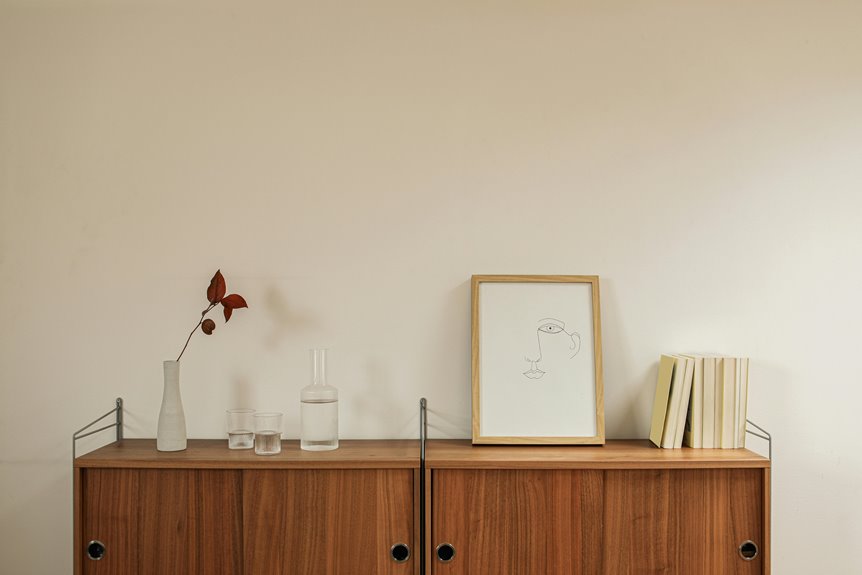Minimalism isn't about living with nothing – it's about living with what truly matters to you. You'll find freedom by decluttering your space, simplifying your schedule, and making mindful choices about what you bring into your life. Start small by tackling one area at a time, like a drawer or closet, and sort items into keep, donate, or discard piles. Focus on quality over quantity in your purchases, and embrace the "one in, one out" rule to maintain your progress. Create meaningful experiences rather than collecting things. Your journey toward a simpler, more intentional life awaits.
What Is Minimalism
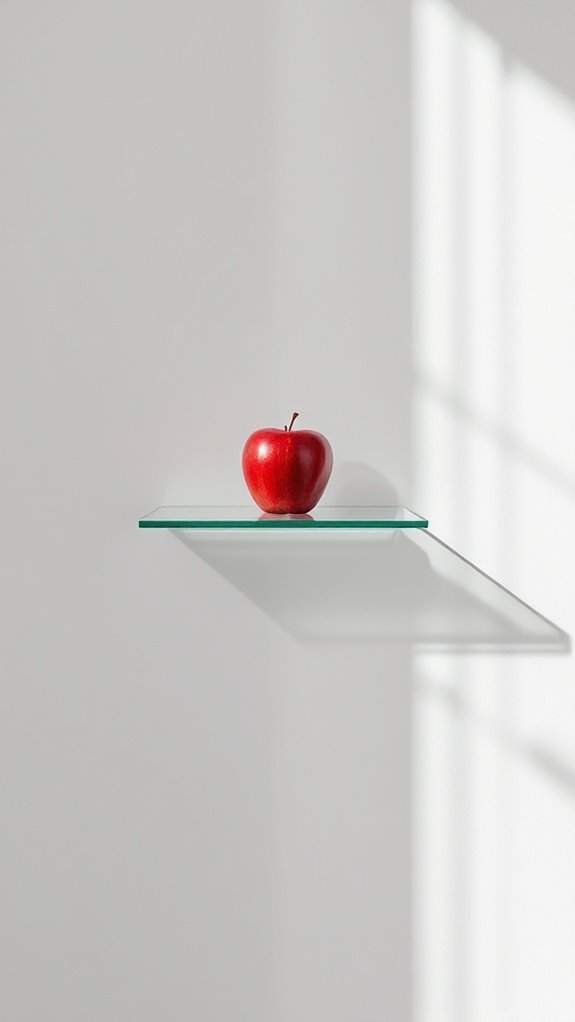
Minimalism isn't just about owning fewer things – it's a purposeful lifestyle focused on finding value and meaning beyond material possessions. At its core, minimalism encourages you to identify what truly matters in your life and eliminate everything else that doesn't serve a clear purpose. This philosophy extends beyond decluttering your physical space to simplifying all aspects of your life, including relationships, commitments, and digital presence.
When you embrace minimalism, you'll learn to distinguish between needs and wants, making conscious decisions about what deserves space in your life. It's about quality over quantity, choosing items and experiences that align with your values and bring genuine joy. You might find yourself questioning societal pressures to accumulate stuff and instead focus on experiences, personal growth, and meaningful connections.
The beauty of minimalism lies in its flexibility – there's no one-size-fits-all approach. You don't need to live with only 100 items or maintain an all-white aesthetic. Instead, you'll develop your own version that fits your lifestyle and goals.
Some people might focus on maintaining a clutter-free home, while others might emphasize minimizing digital distractions or simplifying their schedule.
Minimalism also promotes sustainability and mindful consumption. You'll become more aware of your purchasing habits, environmental impact, and the true cost of ownership. By choosing to live with less, you're not depriving yourself – you're creating space for what matters most in your life.
Benefits of Living With Less
When you start living with less, you'll discover numerous practical and psychological benefits that extend far beyond a tidy home. By embracing minimalism, you'll spend less time cleaning, organizing, and maintaining your possessions. You'll also save money by making more intentional purchases and avoiding impulse buys that often end up as clutter.
Your mental clarity will improve as you reduce visual distractions in your environment. Studies show that cluttered spaces can increase stress hormones and make it harder to focus. With fewer items competing for your attention, you'll find it easier to concentrate on tasks and feel more peaceful in your surroundings.
Financial freedom becomes more attainable when you adopt a minimalist lifestyle. You'll naturally spend less on unnecessary items and might even generate extra income by selling things you don't need. This shift in spending habits often leads to reduced debt and increased savings.
Decision fatigue decreases remarkably when you have fewer choices to make. With a simplified wardrobe, fewer gadgets, and less stuff overall, you'll make faster decisions and free up mental energy for more important matters.
Environmental impact is another meaningful benefit. By consuming less, you'll reduce your carbon footprint and contribute less waste to landfills. You'll also become more mindful of your purchases, often opting for quality items that last longer rather than disposable alternatives.
Your relationships may improve too, as you'll have more time and energy to invest in meaningful connections rather than managing possessions. You might even inspire others to simplify their lives.
Common Minimalism Myths
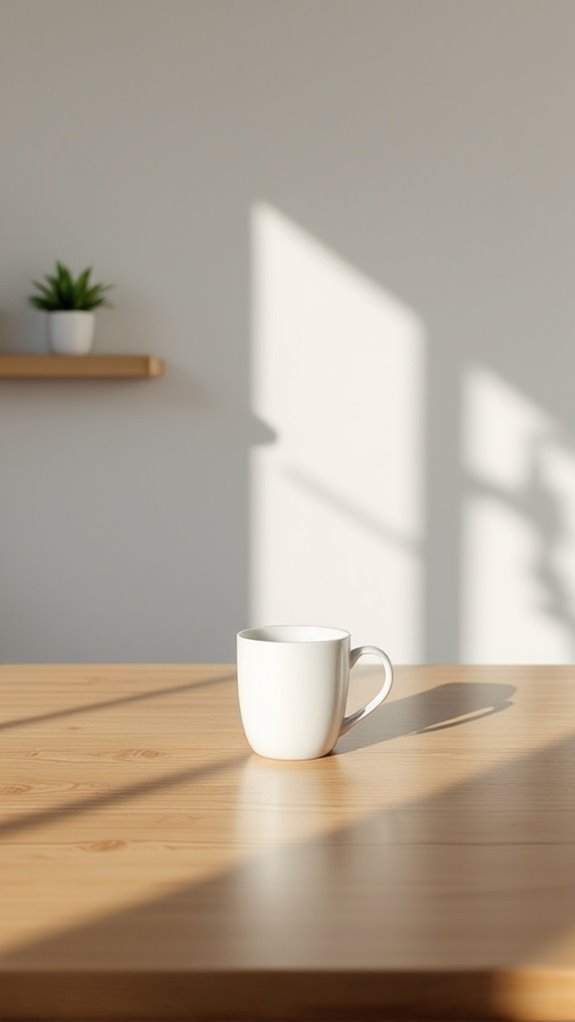
Despite the clear advantages of a simplified lifestyle, many misconceptions about minimalism keep people from exploring its benefits. Let's debunk some of the most persistent myths that might be holding you back from embracing a minimalist lifestyle.
First, minimalism doesn't mean living with empty rooms or owning only 100 items. You don't need to get rid of everything you love or live in a stark white space. Instead, it's about keeping what adds value to your life and eliminating what doesn't. You can still have collections, decorations, and personal items that bring you joy.
Another common myth is that minimalism is only for single people or the wealthy. You can practice minimalism regardless of your family size, income level, or living situation. Whether you're a parent with kids or living on a tight budget, you can adapt minimalist principles to fit your circumstances.
You might've heard that minimalism is all-or-nothing, but that's not true. You don't need to transform your entire life overnight. Start small by decluttering one area or focusing on one category of items. There's no universal standard for being a "proper" minimalist.
Many people also believe that minimalism is anti-technology or anti-consumption. In reality, it's about being intentional with your purchases and digital life. You can own modern devices and buy new things – the key is ensuring they serve a purpose and align with your values rather than accumulating them mindlessly.
Decluttering Your Physical Space
You don't need to tackle your entire home at once when starting your minimalism journey – instead, begin with a single drawer or small area that won't overwhelm you.
Taking this gradual approach lets you build confidence and momentum as you learn to make thoughtful decisions about your belongings.
Once you're comfortable with the process, move methodically through your home room by room, applying the decluttering skills you've developed to larger spaces.
Start Small, Start Simple
Starting your minimalist journey doesn't require a complete lifestyle overhaul – in fact, it's best to begin with small, manageable steps.
Pick one drawer, shelf, or small area to tackle first, rather than attempting to declutter your entire home at once. You'll build confidence and momentum as you complete these smaller tasks.
Begin by removing obvious trash and items you haven't used in the past year.
Then, sort remaining items into three categories: keep, donate, and unsure. For items in the "unsure" pile, box them up and set a reminder to review them in 30 days. If you haven't needed them during that time, you can likely let them go.
Focus on one category of items at a time, such as clothes, books, or kitchen tools.
Ask yourself practical questions: "When did I last use this?" "Does it serve a purpose?" "Do I own something similar that works better?"
This systematic approach helps prevent overwhelm and guarantees thorough decision-making.
Room-by-Room Decluttering Method
Tackling your home room by room creates a structured pathway to minimalism that's both manageable and thorough.
Choose one room as your starting point, preferably a smaller space like a bathroom or guest room, where you can build confidence and momentum. Work clockwise around each room, addressing one section at a time.
Begin by removing everything from a specific area, like a drawer or shelf. Sort items into three piles: keep, donate, and discard.
For items you'll keep, ask yourself: "Have I used this in the past year?" and "Does this add value to my life?" Be ruthless with duplicates and keep only what you truly need.
Once you've sorted everything, clean the empty space thoroughly before returning only the "keep" items. Organize these items efficiently, using drawer dividers or storage containers if necessary.
Don't move to the next room until you've completely finished the current one – partial decluttering often leads to abandoned projects. Remember to immediately remove donation and discard piles from your home to prevent second-guessing your decisions.
Creating a Capsule Wardrobe
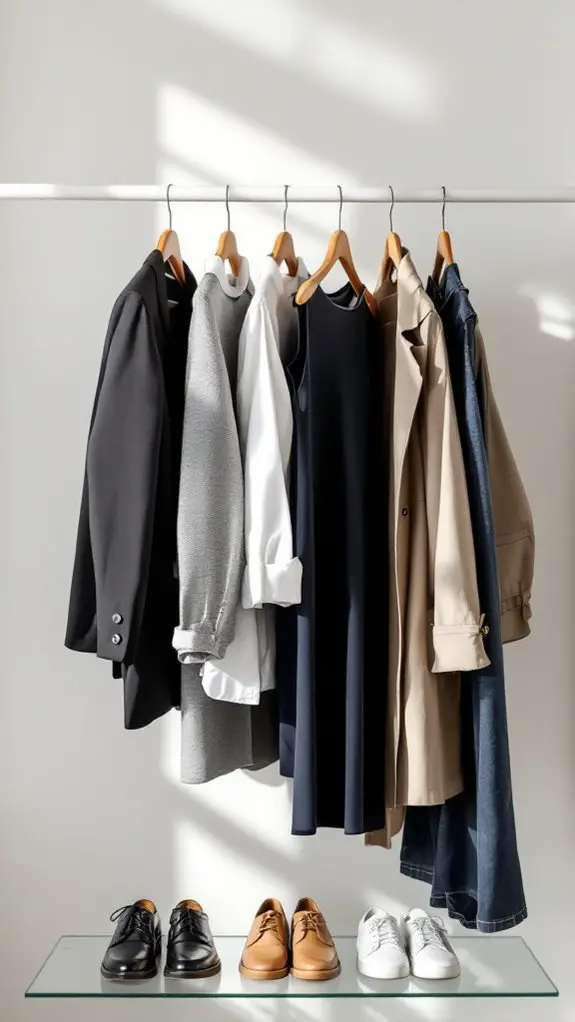
Building a capsule wardrobe marks one of the most impactful steps toward minimalism. A capsule wardrobe consists of versatile, high-quality pieces that you can mix and match to create multiple outfits. You'll want to start with 30-40 core items that reflect your lifestyle, including work, casual, and special occasions.
Begin by emptying your closet and sorting clothes into three piles: keep, donate, and discard. Keep only items that fit well, make you feel confident, and you've worn in the last six months. Select a neutral color palette as your foundation – think black, white, navy, or beige – and add 1-2 accent colors that complement each other.
Your capsule wardrobe should include essential pieces: 2-3 pairs of well-fitted jeans, 2-3 pairs of trousers, 4-5 basic t-shirts, 2-3 button-down shirts, 1-2 blazers, 2-3 sweaters, and 1-2 dresses.
Don't forget seasonal items like a quality coat and weather-appropriate shoes. Choose fabrics that last and coordinate easily.
Once you've established your base pieces, you'll need to maintain your capsule wardrobe. Replace items only when they wear out, and resist impulse purchases. When adding new pieces, follow the "one in, one out" rule to maintain your minimal wardrobe size.
You'll find that having fewer, better-quality clothes saves time getting dressed, reduces decision fatigue, and helps you develop a more defined personal style while consuming less.
Digital Declutter Essentials
Digital clutter can overwhelm your devices and mind just as much as physical clutter affects your space. To regain control, you'll need to tackle your digital life systematically, starting with your most-used devices and accounts.
Begin by organizing your computer's desktop and files. Create a logical folder structure, delete duplicate files, and remove unused programs. Name your files clearly and consistently to make them easily searchable. Move important documents to a cloud storage service, ensuring you've backed up essential data.
Next, address your smartphone. Delete unused apps, clear your cache regularly, and organize remaining apps into folders by category. Unsubscribe from unnecessary email newsletters and remove yourself from unused subscription services. Turn off non-essential notifications to reduce digital distractions.
Take control of your inbox by implementing the "inbox zero" method. Create folders for different email categories, set up filters to automatically sort incoming messages, and immediately delete or archive emails you don't need. Respond to important messages promptly and unsubscribe from promotional emails you never read.
Finally, organize your digital photos. Delete blurry or duplicate images, create albums by date or event, and back up your favorites to a cloud service. Consider using a photo management app to help sort and tag your images efficiently.
Remember to maintain your digital organization by setting aside weekly time for cleanup. Just like physical decluttering, digital minimalism requires regular maintenance to prevent virtual chaos from creeping back into your life.
Mindful Consumption Habits

Beyond organizing your digital world, mindful consumption plays a key role in maintaining a minimalist lifestyle. You'll need to fundamentally shift how you approach purchasing decisions and develop awareness about your actual needs versus wants.
Start by implementing a 24-hour rule for non-essential purchases, giving yourself time to evaluate whether an item will genuinely add value to your life.
Track your spending patterns for two weeks to identify impulse buying triggers. You might discover that you shop when stressed, bored, or influenced by social media advertising.
Create a list of questions to ask yourself before making purchases: "Do I already own something similar?" "Will I use this regularly?" "Does this align with my values and lifestyle goals?"
Practice intentional shopping by researching products thoroughly and prioritizing quality over quantity. Choose versatile items that serve multiple purposes and will last longer.
When you do buy something new, follow the one-in-one-out rule: remove an existing item to maintain balance in your space.
Focus on experiences rather than material possessions. Before acquiring new things, consider borrowing, renting, or sharing resources within your community. This approach not only reduces clutter but also minimizes environmental impact.
Subscribe to fewer marketing emails and unfollow brands on social media to reduce exposure to constant shopping triggers.
Remember that mindful consumption extends beyond physical items to include how you spend your time, energy, and attention. Being selective about what you allow into your life helps maintain the simplicity and purpose that minimalism offers.
Simplifying Your Daily Routine
You can transform your mornings by creating a simple reset ritual that allows you to start each day with intention and clarity.
This reset ritual might include making your bed, a five-minute meditation, or enjoying your coffee in silence before checking any devices.
Once you've established your morning foundation, break down your day into focused time blocks that align with your most important priorities.
Morning Reset Ritual
Starting each morning with a minimalist reset ritual can transform your entire day from chaotic to controlled. This ritual doesn't require elaborate routines or expensive equipment – just a commitment to begin each day with purpose and clarity.
Begin by making your bed immediately after waking up. This simple act creates an instant sense of accomplishment and order in your space.
Next, spend five minutes clearing any clutter that accumulated the previous day. Put away items on nightstands, remove empty glasses, and return clothes to their proper places.
Open your curtains to let in natural light, then take three deep breaths while standing in the sunlight. This practice helps center your mind and connect you with the present moment.
Before checking any devices, write down your top three priorities for the day on a small notepad.
Finally, choose your outfit the night before and lay it out neatly. This eliminates decision fatigue and prevents morning chaos.
Edit Daily Time Blocks
Once your morning reset ritual becomes second nature, the next step in minimalist living involves streamlining your daily schedule.
Start by dividing your day into distinct time blocks that align with your energy levels and priorities. Allocate specific periods for focused work, personal care, and essential tasks while eliminating time-wasting activities.
Review your current schedule and identify areas where you're overcommitting or spending time inefficiently. Cut out unnecessary meetings, reduce social media usage, and combine similar tasks to minimize context switching.
Create buffer zones between activities to prevent overwhelm and maintain mental clarity.
Designate specific time blocks for different categories: deep work (2-3 hours), communication (email and calls), physical activity, and personal development. Protect these blocks by setting boundaries and learning to say no to non-essential commitments.
Keep your schedule flexible enough to accommodate unexpected situations while maintaining your core priorities.
Remember that effective time blocking isn't about filling every minute but creating intentional spaces for what matters most. Regularly evaluate and adjust your blocks to guarantee they continue serving your minimalist lifestyle goals.
Organizing Your Living Space
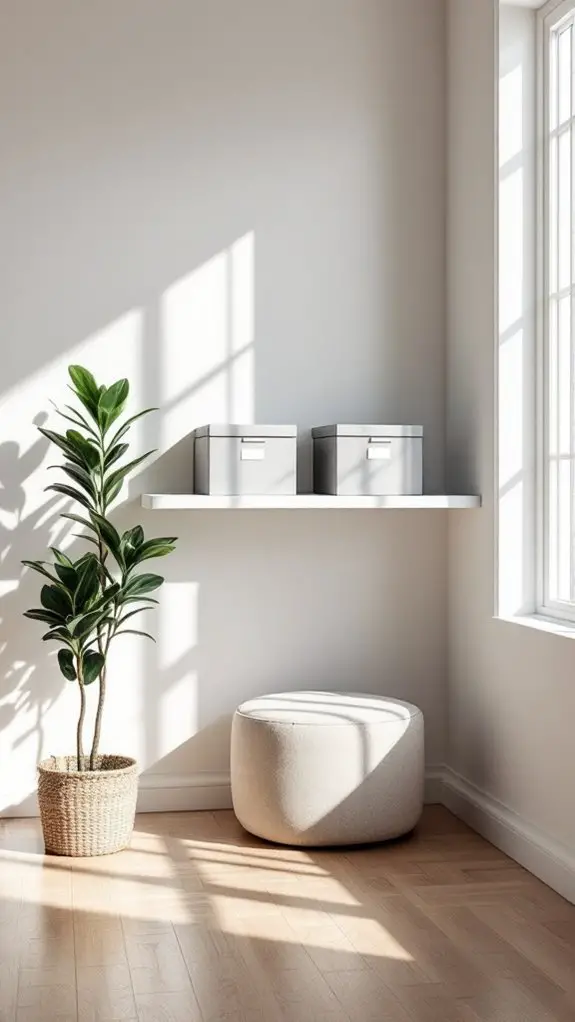
A clutter-free living space creates instant peace of mind and sets the foundation for a minimalist lifestyle. To begin organizing your space, start with a quick walkthrough of your home and identify areas that need immediate attention.
Make a list of these spaces and tackle them one at a time to avoid feeling overwhelmed.
Begin with the visible areas first, like countertops, tables, and floors. Remove items that don't belong and return them to their proper places.
Next, focus on storage spaces such as closets, drawers, and cabinets. Sort items into three categories: keep, donate, and discard. Only keep items you've used within the past year or that hold genuine sentimental value.
Create designated zones for different activities in your home. Your workspace should contain only work-related items, while your bedroom should focus on rest and relaxation.
Install simple storage solutions like hooks, shelves, and bins to keep everything organized and easily accessible.
Maintain your newly organized space by following the "one in, one out" rule – when you bring in a new item, remove an old one.
Don't let papers pile up; deal with mail and documents immediately. Create a daily five-minute cleanup routine to prevent clutter from accumulating.
Remember that organizing isn't a one-time event but an ongoing process. You'll need to regularly assess your space and make adjustments as your needs change.
Start small, be consistent, and you'll find that maintaining an organized living space becomes second nature.
Letting Go of Sentimental Items
While organizing your living space can feel relatively straightforward, dealing with sentimental items often presents the biggest challenge in minimalism. These objects carry emotional weight and memories, making them particularly difficult to evaluate objectively.
You'll need to approach this process with patience and self-compassion, understanding that it's okay to keep truly meaningful items while still reducing overall clutter.
Start by gathering all your sentimental items in one place and sorting them into categories like childhood memorabilia, family heirlooms, and gift collections. Ask yourself critical questions about each item: Does it bring you genuine joy? Would the memory remain without the physical object? Could you preserve the memory through a photograph instead?
Consider creating a digital archive of your memories. Scan old letters, photograph special objects, and create digital albums that preserve the emotional connection without taking up physical space.
For inherited items, remember that you're not dishonoring loved ones by letting go of things that don't fit your life.
Set reasonable limits for sentimental collections. Choose one or two representative pieces rather than keeping everything. For instance, select your favorite childhood toy instead of maintaining the entire collection.
If you're struggling with certain items, create a "maybe box" and revisit it in six months. You'll often find that time provides clarity and emotional distance, making decisions easier.
Remember that the goal isn't to eliminate all sentimental items but to keep only those that truly enrich your present life.
Minimalist Money Management
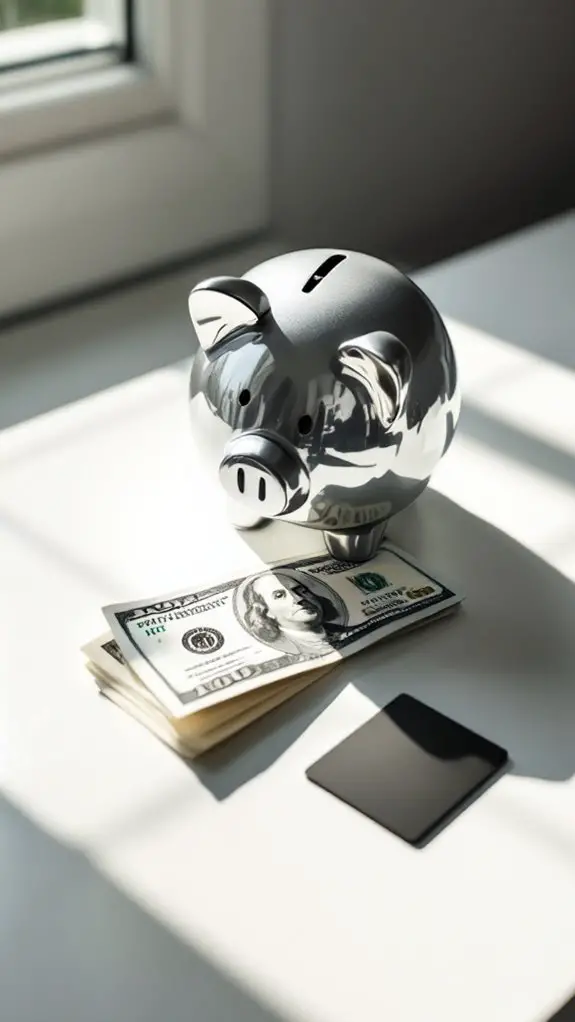
When you're ready to embrace minimalist money management, start by consolidating your accounts to keep your finances streamlined and easy to monitor.
You'll want to merge multiple checking accounts into one primary account and close any unused credit cards that might tempt you to overspend.
Keeping a detailed record of your assets and liabilities will help you maintain clear visibility of your financial picture and make smarter money decisions.
Simplify Your Financial Accounts
Managing multiple financial accounts can feel like juggling too many balls at once. When you're tracking numerous checking accounts, savings accounts, and credit cards, you'll likely miss important transactions or lose sight of your overall financial picture. Simplifying your accounts creates clarity and makes your money easier to manage.
Start by listing all your current accounts, then identify which ones you actively use and which have become dormant. Close any unused accounts and consolidate your banking to one primary checking account and one savings account.
If you have multiple credit cards, keep only one or two that offer the best rewards for your spending habits. Consider switching to a single bank for both checking and savings – this streamlines your online banking and eliminates the need to transfer money between institutions.
Set up automatic bill payments through your primary checking account and link your credit cards to it. You'll also want to maintain one emergency fund account and one long-term savings account.
This simplified structure lets you track your money more effectively and reduces the time you spend managing your finances.
Track Everything You Own
Taking stock of your possessions serves as an essential first step in minimalist money management. You'll need to create a detailed inventory of everything you own, from major purchases like electronics and furniture to smaller items like clothing and kitchenware. This process helps you understand your current financial commitments and identifies areas where you're overspending.
Start by going room by room, documenting each item's description, purchase date, and estimated current value. Use a spreadsheet or inventory app to maintain this list, making it easier to update and analyze your possessions over time.
Don't forget to include items in storage, your garage, or other less-visited spaces.
Once you've completed your inventory, categorize items based on their necessity and frequency of use. This classification will help you identify redundant items and unnecessary purchases.
You'll also want to note items that require regular maintenance or replacement, as these ongoing costs impact your budget. By maintaining an accurate record of your belongings, you'll make more informed decisions about future purchases and better understand your actual needs versus wants.
Streamlining Your Work Life
Throughout the workday, your desk and digital spaces can quickly become cluttered with unnecessary items, notifications, and tasks that drain your productivity. To streamline your work life, start by decluttering your physical workspace.
Keep only essential items on your desk: your computer, a notebook, and perhaps one or two tools you use daily. Store everything else in designated drawers or remove them completely.
Digital minimalism is equally important. Unsubscribe from unnecessary email newsletters, disable non-essential notifications on your devices, and organize your computer files into a simple, logical system.
Create folders for current projects and archive completed ones. Delete or archive files you haven't accessed in the past year.
Simplify your workflow by identifying and eliminating time-wasting activities. Use time-blocking to structure your day, dedicating specific periods for focused work, meetings, and email management.
Install website blockers to prevent mindless browsing, and turn off your phone during deep work sessions.
Evaluate your commitments and learn to say no to projects that don't align with your primary objectives. Automate repetitive tasks using tools and templates, and delegate responsibilities when possible.
Keep your to-do list lean by focusing on three to five priority tasks each day.
Maintain your streamlined work environment by implementing a "clean desk" policy at day's end. Spend the last few minutes of each workday clearing your desk, closing unnecessary browser tabs, and planning your priorities for tomorrow.
This reset guarantees you'll start each morning with a clear space and focused mind.
Creating Meaningful Experiences

When you embrace minimalism, you'll discover that meaningful experiences don't require grand gestures or expensive outings.
You can find deep satisfaction in choosing one thoughtful activity over multiple rushed events, whether it's a quiet afternoon with a close friend or a solo nature walk.
Choose Quality Over Quantity
A life filled with meaningful experiences brings more joy than one cluttered with shallow moments. This principle extends to your possessions, where choosing quality items over numerous cheaper alternatives can transform your lifestyle. When you invest in well-made products, you'll spend less time and money replacing broken items and more time enjoying what you own.
Start by evaluating your current belongings. Ask yourself if each item serves a genuine purpose or brings real value to your life. Rather than buying multiple versions of the same thing, invest in one high-quality piece that'll last for years. You'll find that a single well-made coat serves you better than three cheaper ones that wear out quickly.
This approach also helps you become more intentional with your purchases. Before buying something new, research its durability, functionality, and craftsmanship.
Consider the item's long-term cost per use rather than just its initial price tag. Remember, quality items often come with better warranties, superior materials, and thoughtful design features that enhance your daily experience.
Focus on Simple Joys
Beyond material possessions, minimalism invites you to find joy in life's simple pleasures. Instead of chasing expensive thrills or status symbols, you'll discover contentment in everyday moments – a quiet morning coffee, a walk in nature, or meaningful conversations with loved ones.
These experiences don't clutter your space or drain your bank account, yet they create lasting memories and genuine happiness.
Start by identifying activities that truly spark joy in your life. Maybe it's reading in a sunny corner, cooking from scratch, or practicing meditation. Create time for these simple pleasures by eliminating distractions and unnecessary commitments.
You'll notice that the most fulfilling experiences often cost little or nothing at all.
Embrace the power of presence in your daily routines. When you eat, savor each bite. When you exercise, focus on how your body feels. When you spend time with others, engage fully in the conversation.
Maintaining a Minimalist Lifestyle
Maintaining your minimalist lifestyle requires consistent dedication and mindful choices. You'll need to regularly evaluate your possessions, habits, and commitments to guarantee they align with your minimalist values. Start by establishing clear guidelines for what enters your life, whether it's new purchases, activities, or relationships.
Create a one-in-one-out rule for your belongings: whenever you bring something new home, remove something else. Schedule monthly decluttering sessions to prevent items from accumulating, and regularly assess whether your possessions still serve a purpose in your life.
Don't forget to apply minimalism to your digital space by organizing files, unsubscribing from unnecessary emails, and limiting social media consumption.
Make mindful spending a cornerstone of your minimalist practice. Before making purchases, wait 24-48 hours to determine if you truly need the item. Keep a list of your essential needs and stick to it when shopping. You'll find that questioning each purchase helps maintain both your space and financial well-being.
Remember that minimalism extends beyond physical items. Regularly evaluate your commitments and learn to say no to activities that don't align with your priorities. Keep your calendar intentionally spacious to allow time for what truly matters.
Consider implementing a morning routine that sets a peaceful tone for your day, helping you maintain focus on your minimalist goals.
Stay connected with like-minded individuals who support your minimalist journey, whether through local groups or online communities. Their encouragement and shared experiences can help you stay motivated when challenges arise.
Building Better Shopping Habits
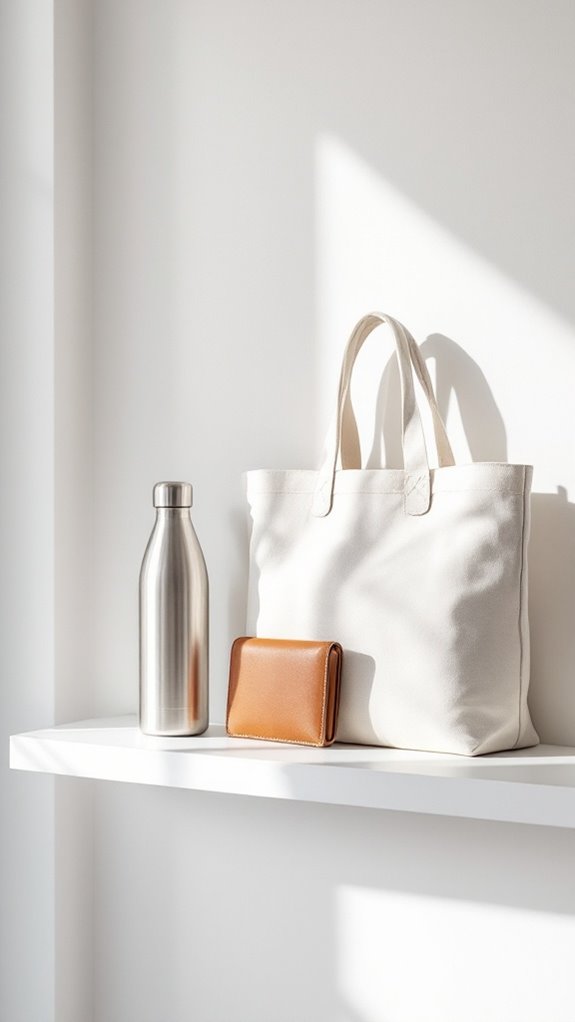
Smart shopping habits form the foundation of a lasting minimalist lifestyle. You'll need to rewire your approach to purchasing by implementing thoughtful strategies that prevent impulsive buying and unnecessary accumulation. Start by creating a mandatory waiting period of 48 hours before making any non-essential purchase, giving yourself time to evaluate whether you truly need the item.
Before shopping, make detailed lists and stick to them religiously. When you enter a store, head directly to the items you need instead of browsing aimlessly. Unsubscribe from promotional emails and avoid sales unless you've planned to buy specific items. You'll find that removing these temptations markedly reduces impulse purchases.
Practice the "one in, one out" rule – whenever you buy something new, remove a similar item from your home. This maintains balance and prevents clutter from creeping back.
When you do need to make a purchase, invest in quality items that'll last longer rather than cheap alternatives you'll need to replace frequently. Consider borrowing or renting items you'll only use occasionally. Tools, formal wear, and seasonal equipment often sit unused for months, taking up valuable space.
You can also explore secondhand options for many purchases, which saves money and reduces environmental impact. Track your spending habits in a dedicated app or notebook, noting not just what you buy but why. This awareness helps identify emotional spending triggers and shopping patterns you'll want to change.

Erzsebet Frey (Eli Frey) is an ecologist and online entrepreneur with a Master of Science in Ecology from the University of Belgrade. Originally from Serbia, she has lived in Sri Lanka since 2017. Eli has worked internationally in countries like Oman, Brazil, Germany, and Sri Lanka. In 2018, she expanded into SEO and blogging, completing courses from UC Davis and Edinburgh. Eli has founded multiple websites focused on biology, ecology, environmental science, sustainable and simple living, and outdoor activities. She enjoys creating nature and simple living videos on YouTube and participates in speleology, diving, and hiking.

